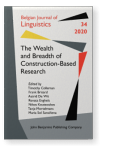Strange sounds, familiar words
Interlingual decoding from a CxG perspective
When communicating across closely related languages or varieties (e.g. in interdialectal communication or in
regions such as Mainland Scandinavia), speakers have to learn how to decode words that show partial phonological differences from
the equivalents in their L1. Although contact situations like these are rather common, interlingual decoding has scarcely been
addressed in the CxG literature. As a contribution to this field of research, the paper discusses how (a particular stage in)
emerging receptive multilingualism can be modelled from a CxG perspective. Specifically, it deals with the idea that repeated
interlingual decoding generates partially schematic cross-linguistic constructions mirroring the speaker’s knowledge about sound
correspondences, as suggested by Diasystematic Construction Grammar (
Höder 2019).
Article outline
- 1.Learning to decode across linguistic boundaries
- 2.An ordinary (but underinvestigated) phenomenon
- 3.Perspective and research questions
- 4.Diasystematic construction grammar
- 5.Example analysis
- 6.Conclusion
- Acknowledgements
- Notes
-
References
References (22)
References
Bannert, Robert. 1981. “Referat av diskussionen i sektionen Talperceptionsforskning och nordisk hörförståelse [Report on the discussion in the section Spoken Language Perception and Nordic listening
comprehension].” In Internordisk språkförståelse: Föredrag och diskussioner vid ett symposium på Rungstedgaard utanför Köpenhamn
den 24–26 mars 1980, anordnat av Sekretariatet för Nordiskt Kulturellt Samarbete vid Nordiska Ministerrådet [Internordic speech comprehension: Presentations and discussions at a symposium at Rungstedgaard
outside Copenhagen on March 24–26, 1980, commissioned by Sekretariatet för Nordiskt Kulturellt Samarbete at
Nordiska Ministerrådet
], ed. by Claes-Christian Elert, 37–45. Umeå: Universitetet i Umeå.
Braunmüller, Kurt. 1995. “Semikommunikation und semiotische Strategien. Bausteine zu einem Modell für die Verständigung im Norden zur Zeit
der Hanse.” In Niederdeutsch und die skandinavischen Sprachen, vol. 21, ed. by Kurt Braunmüller, 35–70. Heidelberg: Winter.
Braunmüller, Kurt. 2008. On the Relevance of Receptive Multilingualism in a Globalised World: Theory, History and Evidence from Today’s
Scandinavia. Hamburg: Universität Hamburg, Sonderforschungsgebiet Mehrsprachigkeit.
Bybee, Joan L. 2010. Language, Usage, and Cognition. Cambridge: Cambridge University Press. 

Delsing, Lars-Olof, and Katarina Lundin Åkesson. 2005. Håller språket ihop Norden? En forskningsrapport om ungdomars förståelse av danska, svenska och
norska [Does language hold the North together? A research report on adolescents’ comprehension skills in
Danish, Swedish and Norwegian]. Copenhagen: Nordiska Ministerrådet. 

Ellis, Nick C., and Stefanie Wulff. 2019. “Cognitive Approaches to L2 Acquisition.” In The Cambridge Handbook of Language Learning, ed. by John W. Schwieter, and Alessandro G. Benati, 41–61. Cambridge: Cambridge University Press. 

Goldberg, Adele. 2019. Explain Me This. Creativity, Competition, and the Partial Productivity of Constructions. Princeton, Oxford: Princeton University Press.
Gooskens, Charlotte, and Renée van Bezooijen. 2013. “Explaining Danish-Swedish Asymmetric Word Intelligibility. An Error Analysis.” In Phonetics in Europe: Perception and Production, ed. by Charlotte Gooskens, and Renée van Bezooijen, 59–82. Frankfurt am Main: Peter Lang.
Hilpert, Martin. 2019. “Higher-order Schemas in Morphology: What They Are, How They Work, and Where to Find Them.” Word Structure 12 (3): 261–273. 

Höder, Steffen. 2019. “Phonological Schematicity in Multilingual Constructions: A Diasystematic Perspective on Lexical
Form.” Word Structure 12 (3): 334–352. 

Klein, Horst G., and Tilbert D. Stegmann. 2000. EuroComRom – Die sieben Siebe. Romanische Sprachen sofort lesen können. 2nd ed. Aachen: Shaker.
Möller, Robert, and Ludger Zeevaert. 2015. “Investigating Word Recognition in Intercomprehension: Methods and Findings.” Linguistics 53 (2): 313–352. 

Pulvermüller, Friedemann. 1996. “Hebb’s Concept of Cell Assemblies and the Psychophysiology of Word Processing.” Psychophysiology 33 (4): 317–333. 

Sandøy, Helge. 2005. “The Typological Development of the Nordic Languages I: Phonology.” In The Nordic Languages. An International Handbook of the North Germanic Languages, vol. 21, ed. by Oskar Bandle, Kurt Braunmüller, Ernst Håkon Jahr, Allan Karker, Hans-Peter Naumann, and Ulf Teleman, 1852–1871. Berlin/New York: De Gruyter.
van Heuven, Vincent J. 2008. “Making Sense of Strange Sounds: (Mutual) Intelligibility of Related Language Varieties. A Review.” International Journal of Humanities and Arts Computing 2 (1–2): 39–62. 

Vanhove, Jan. 2016. “The Early Learning of Interlingual Correspondence Rules in Receptive Multilingualism.” International Journal of Bilingualism 20 (5): 580–593. 

Vihman, Marilyn, and William Croft. 2007. “Phonological Development: Toward a ‘Radical’ Templatic Phonology.” Linguistics 45 (4): 683–725. 

Weinreich, Uriel. 1954. “Is a Structural Dialectology Possible?” Word 101: 388–400. 

Weinreich, Uriel. 1964. Languages in Contact: Findings and Problems. 3rd ed. London: Mouton.
Zeldes, Amir. 2012. Productivity in Argument Selection: From Morphology to Syntax. Berlin/New York: De Gruyter. 

Cited by (1)
Cited by one other publication
This list is based on CrossRef data as of 4 july 2024. Please note that it may not be complete. Sources presented here have been supplied by the respective publishers.
Any errors therein should be reported to them.
